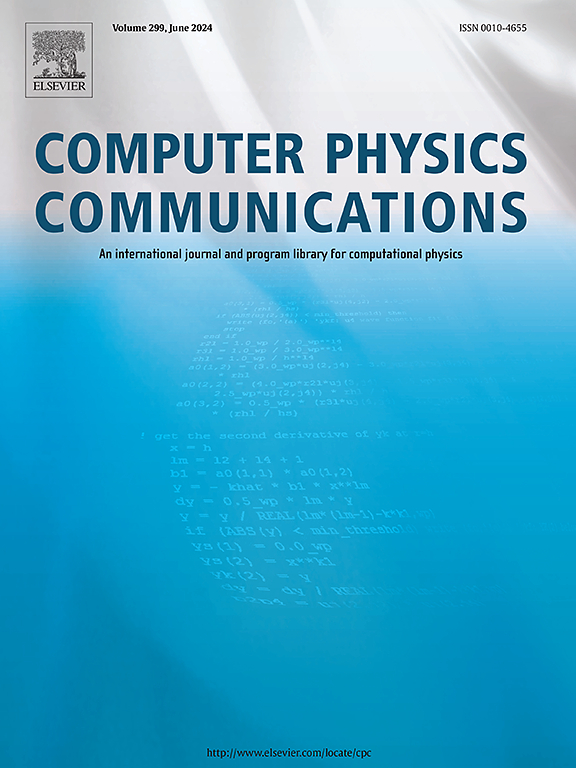gSeaGen code by KM3NeT: An efficient tool to propagate muons simulated with CORSIKA
IF 3.4
2区 物理与天体物理
Q1 COMPUTER SCIENCE, INTERDISCIPLINARY APPLICATIONS
引用次数: 0
Abstract
The KM3NeT Collaboration has tackled a common challenge faced by the astroparticle physics community, namely adapting the experiment-specific simulation software to work with the CORSIKA air shower simulation output. The proposed solution is an extension of the open source code gSeaGen, which allows the transport of muons generated by CORSIKA to a detector of any size at an arbitrary depth. The gSeaGen code was not only extended in terms of functionality but also underwent a thorough redesign of the muon propagation routine, resulting in a more accurate and efficient simulation. This paper presents the capabilities of the new gSeaGen code as well as prospects for further developments.
Program summary
Program title: gSeaGen
CPC Library link to program files: https://doi.org/10.17632/ymgxvy2br4.2
Developer's respository link: git.km3net.de/opensource/gseagen
Licensing provisions: BSD 3-Clause
Programming language: C++
Nature of problem: Integration of the state-of-the-art extensive air shower Monte Carlo event generator CORSIKA [1] into the atmospheric muon simulation for water Cherenkov neutrino telescopes. The primary use case considered is the KM3NeT experiment [2], however, the code should be able to cover other similar experiments as well. The challenges in this work included interfacing the CORSIKA binary output, efficient handling of already generated events to reduce the overall computational cost, and preserving all the additional available information, which can be invaluable in physics analyses.
Solution method: The readout of CORSIKA simulation was adapted from the base script provided together with CORSIKA and implemented as a standalone flux driver in gSeaGen. The propagation routine has been redesigned to support the geometry of extensive air shower simulations and to improve its efficiency in propagating particles to the detector. To ensure a reliable modelling of muon energy loss and scattering, PROPOSAL [3] was set as the default internal code for muon transport. PROPOSAL is an open-source software developed and maintained by the IceCube collaboration [4] and is a well-established solution used by the neutrino physics community.
Additional comments including restrictions and unusual features: The code was tested with GENIE [5] version 3.4.0 and PROPOSAL 6.1.5. Currently, linking of gSeaGen to GENIE is mandatory, even in the case of a muon-only simulation using CORSIKA.
References
- [1]D. Heck et al., FZKA-6019 (1998).
- [2]S. Adrián-Martínez et al., J. Phys. G, Nucl. Part. Phys. 43 (2016) 084001.
- [3]J.H. Koehne et al., Comput. Phys. Commun. 184 (2013) 2070.
- [4]M.G. Aartsen et al., J. Instrum. 12 (2017) P03012.
- [5]C. Andreopoulos et al., Nucl. Instrum. Methods A 614 (2010) 87.
用KM3NeT编写的gSeaGen代码:一个用CORSIKA模拟的有效的介子传播工具
KM3NeT协作解决了天体粒子物理学界面临的一个共同挑战,即使实验特定的模拟软件与CORSIKA风淋模拟输出一起工作。提出的解决方案是对开放源代码gSeaGen的扩展,它允许将CORSIKA产生的μ子传输到任意深度的任何大小的探测器上。gSeaGen代码不仅在功能上进行了扩展,而且还对介子传播程序进行了彻底的重新设计,从而实现了更准确、更有效的模拟。本文介绍了新的gSeaGen代码的功能以及进一步发展的前景。程序摘要程序标题:gSeaGenCPC库链接到程序文件:https://doi.org/10.17632/ymgxvy2br4.2Developer's责任链接:git.km3net.de/opensource/ gseagen许可条款:BSD 3- clause编程语言:c++问题的性质:将最先进的广泛空气喷流蒙特卡罗事件生成器CORSIKA[1]集成到水切伦科夫中微子望远镜的大气μ子模拟中。考虑的主要用例是KM3NeT实验[2],但是,代码也应该能够涵盖其他类似的实验。这项工作的挑战包括连接CORSIKA二进制输出,有效处理已经生成的事件以降低总体计算成本,以及保留所有额外的可用信息,这些信息在物理分析中是无价的。解决方法:CORSIKA仿真的读出是根据CORSIKA提供的基本脚本改编的,并在gSeaGen中作为独立的通量驱动程序实现。传播程序已被重新设计,以支持广泛的空气淋点模拟的几何形状,并提高其传播粒子到探测器的效率。为了确保对μ子能量损失和散射的可靠建模,将PROPOSAL[3]设置为μ子输运的默认内部代码。PROPOSAL是由IceCube合作[4]开发和维护的开源软件,是中微子物理社区使用的成熟解决方案。附加注释,包括限制和不寻常的功能:代码在GENIE[5]版本3.4.0和PROPOSAL 6.1.5中进行了测试。目前,gSeaGen与GENIE的链接是强制性的,即使在使用corsika进行仅介子模拟的情况下也是如此。海克等,FZKA-6019(1998)。Adrián-Martínez et al., J.物理学。G,诊断。部分。[4]刘建军,刘建军。物理学报,43 (2016):084001.Koehne等人,计算机。理论物理。common . 184 (2013) 2070.[4]M.G.[j] .中国生物医学工程学报,2016,(6):555 - 557 .]Andreopoulos等人,核。Instrum。方法A 614(2010) 87。
本文章由计算机程序翻译,如有差异,请以英文原文为准。
求助全文
约1分钟内获得全文
求助全文
来源期刊

Computer Physics Communications
物理-计算机:跨学科应用
CiteScore
12.10
自引率
3.20%
发文量
287
审稿时长
5.3 months
期刊介绍:
The focus of CPC is on contemporary computational methods and techniques and their implementation, the effectiveness of which will normally be evidenced by the author(s) within the context of a substantive problem in physics. Within this setting CPC publishes two types of paper.
Computer Programs in Physics (CPiP)
These papers describe significant computer programs to be archived in the CPC Program Library which is held in the Mendeley Data repository. The submitted software must be covered by an approved open source licence. Papers and associated computer programs that address a problem of contemporary interest in physics that cannot be solved by current software are particularly encouraged.
Computational Physics Papers (CP)
These are research papers in, but are not limited to, the following themes across computational physics and related disciplines.
mathematical and numerical methods and algorithms;
computational models including those associated with the design, control and analysis of experiments; and
algebraic computation.
Each will normally include software implementation and performance details. The software implementation should, ideally, be available via GitHub, Zenodo or an institutional repository.In addition, research papers on the impact of advanced computer architecture and special purpose computers on computing in the physical sciences and software topics related to, and of importance in, the physical sciences may be considered.
 求助内容:
求助内容: 应助结果提醒方式:
应助结果提醒方式:


